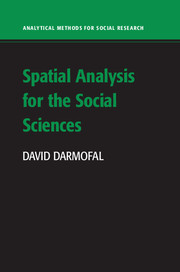Crossref Citations
This Book has been
cited by the following publications. This list is generated based on data provided by Crossref.
Matthews, Stephen A.
2016.
Recapturing Space: New Middle-Range Theory in Spatial Demography.
p.
355.
Jäckle, Sebastian
2017.
Neue Trends in den Sozialwissenschaften.
p.
115.
Harbers, Imke
and
Ingram, Matthew C.
2017.
Geo-Nested Analysis: Mixed-Methods Research with Spatially Dependent Data.
Political Analysis,
Vol. 25,
Issue. 3,
p.
289.
Ingram, Matthew C.
and
Marchesini da Costa, Marcelo
2017.
A Spatial Analysis of Homicide Across Brazil’s Municipalities.
Homicide Studies,
Vol. 21,
Issue. 2,
p.
87.
Weidmann, Nils B.
and
Gleditsch, Kristian Skrede
2018.
Handbuch Organisationssoziologie.
p.
1.
Copelovitch, Mark
Gandrud, Christopher
and
Hallerberg, Mark
2018.
Financial Data Transparency, International Institutions, and Sovereign Borrowing Costs.
International Studies Quarterly,
Vol. 62,
Issue. 1,
p.
23.
Labron Carter, Perry
M. Post, Jason
and
L. Sorrensen, Cynthia
2018.
Spatial Environmental Inequality in Lubbock, Texas.
Current Research Journal of Social Sciences and Humanities,
Vol. 1,
Issue. 1,
p.
01.
Hughes, Sara
Miller Runfola, Daniel
and
Cormier, Benjamin
2018.
Issue Proximity and Policy Response in Local Governments.
Review of Policy Research,
Vol. 35,
Issue. 2,
p.
192.
Oke, Olufolajimi
Bhalla, Kavi
Love, David C.
and
Siddiqui, Sauleh
2018.
Spatial associations in global household bicycle ownership.
Annals of Operations Research,
Vol. 263,
Issue. 1-2,
p.
529.
Yaskewich, David M.
2018.
Public Interest in Veterans’ Lottery Tickets.
Armed Forces & Society,
Vol. 44,
Issue. 3,
p.
408.
Liu, Yupeng
Chen, Wei-Qiang
Lin, Tao
and
Gao, Lijie
2019.
How Spatial Analysis Can Help Enhance Material Stocks and Flows Analysis?.
Resources,
Vol. 8,
Issue. 1,
p.
46.
Johnston, Ron
2019.
David Darmofal and Ryan Strickler: Demography, Politics and Partisan Polarization in the United States, 1828–2016.
Spatial Demography,
Vol. 7,
Issue. 1,
p.
105.
Darmofal, David
Kelly, Nathan J.
Witko, Christopher
and
Young, Sarah
2019.
Federalism, Government Liberalism, and Union Weakness in America.
State Politics & Policy Quarterly,
Vol. 19,
Issue. 4,
p.
428.
Lipsmeyer, Christine S.
Philips, Andrew Q.
Rutherford, Amanda
and
Whitten, Guy D.
2019.
Comparing Dynamic Pies: A Strategy for Modeling Compositional Variables in Time and Space.
Political Science Research and Methods,
Vol. 7,
Issue. 3,
p.
523.
Auspurg, Katrin
Brüderl, Josef
and
Wöhler, Thomas
2019.
Does Immigration Reduce the Support for Welfare Spending? A Cautionary Tale on Spatial Panel Data Analysis.
American Sociological Review,
Vol. 84,
Issue. 4,
p.
754.
Li, Miaoqi
and
Kang, Emily L.
2019.
Randomized algorithms of maximum likelihood estimation with spatial autoregressive models for large-scale networks.
Statistics and Computing,
Vol. 29,
Issue. 5,
p.
1165.
Carreras, Miguel
Irepoglu Carreras, Yasemin
and
Bowler, Shaun
2019.
Long-Term Economic Distress, Cultural Backlash, and Support for Brexit.
Comparative Political Studies,
Vol. 52,
Issue. 9,
p.
1396.
Darmofal, David
and
Strickler, Ryan
2019.
Demography, Politics, and Partisan Polarization in the United States, 1828–2016.
p.
101.
Eaton, Kent
Faguet, Jean-Paul
Harbers, Imke
Schakel, Arjan H.
Hooghe, Liesbet
Marks, Gary
Niedzwiecki, Sara
Osterkatz, Sandra Chapman
and
Shair-Rosenfield, Sarah
2019.
Measuring and theorizing regional governance.
Territory, Politics, Governance,
Vol. 7,
Issue. 2,
p.
265.
Harbers, Imke
and
Ingram, Matthew C.
2019.
Inside Countries.
p.
57.



